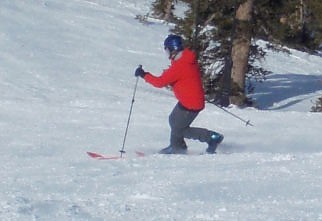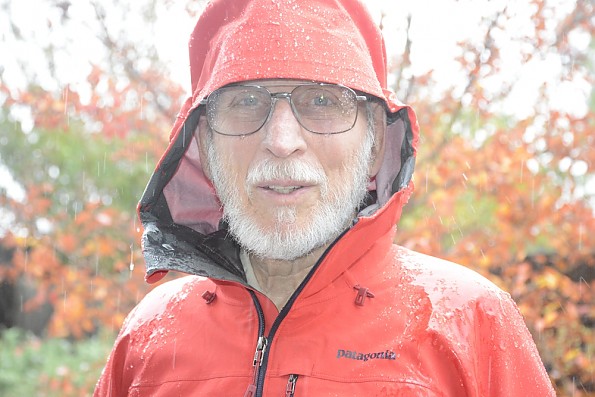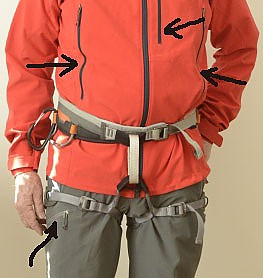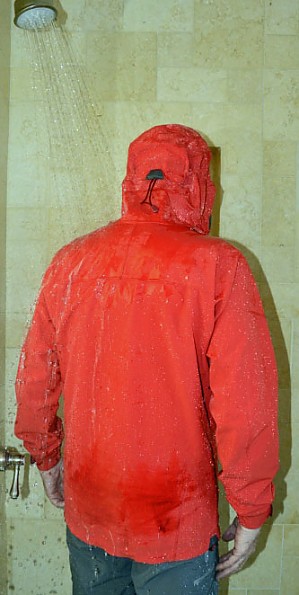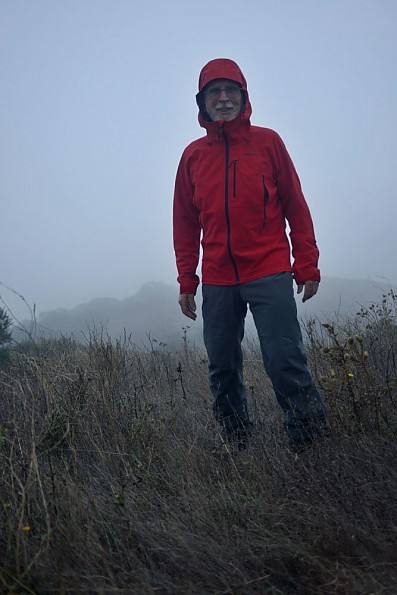Patagonia Knifeblade Jacket
The Knifeblade Jacket has been discontinued. If you're looking for something new, check out the best soft shell jackets for 2025.

The Patagonia Knifeblade Jacket is referred to as filling the gap between between traditional softshells and hardshells. However, as with the Knifeblade pant, it is more soft shell than hard shell – it does wet out and leak some in a heavy downpour, while fairly wind-resistant and water repellent in light drizzle, so more wind and water resistant than the typical soft shell.
It is well-suited to use in dry snow conditions someplace like the higher altitudes in the Andes or Alaska Range, Antarctica, or the light fluffy powder in the Wasatch, Colorado Rockies, or Tetons.
Pros
- Breathes well, while being fairly wind resistant
- Hood fits over helmet
- Water resistant to light rain or snow
- Pocket placement allows access while wearing a climbing harness
Cons
- One-way zipper on jacket closure (should be 2-way for use with climbing harness)
- No pitzips on the jacket
- Wets out and leaks water in heavy rain
- No seam sealing
Weight: 18.5 oz/504 gm
Freeheeling it on a gentle run at Alta
Background: Clothing for climbing (especially alpine climbing and mountaineering) and skiing (particularly backcountry skiing) has a number of demands that are quite specialized. These include a wide range of temperatures and changeable conditions (sometimes rapid changes). The approach may involve hiking with a pack full of rock gear along with ice tools and crampons, followed by scrambling up more or less technical rock pitches (which can be as abrasive on the clothing as sandstone or large-crystal granitic rocks), along with glacier travel and water ice passages. Sometimes bushwhacking through vegetation that tries to snag and rip the garments is involved.
Crampon points can cut through the garment. Because some parts of the ascent require a lot of effort, and hence heating, while other sections of the same climb may be at very cold temperatures with windchills, clothing layers often have to be changed during the course of the day. The challenge is having the clothing simultaneously offer wind resistance, breathability, and water resistance, conflicting requirements that also dictate layering.
The water beading up in our solitary rain "storm" (aka "drizzle") so far this "rainy" season
Much discussion and advertising has centered on having soft shells that breathe, yet are wind and water resistant, versus hard shells which are waterproof and windproof, yet breathe sufficiently to keep the climber or skier cool.
Details: Patagonia is a company which has been around for many years. They are based in Ventura, California, although much of their clothing is manufactured in Asia. The company, founded and still run by the famous climber, Yvon Chouinard, is very environmentally conscious. They are also one of the leaders in vetting their off-shore suppliers. I have owned and heavily used a number of their items on six of the seven continents for climbing, backpacking, and skiing. I recently wrote review of Houdini wind shirt.
I have found their gear to be well made and durable, plus their sizes fit me pretty well. Their gear has become very popular, not only among climbers, but among many non-climbers who want to look “outdoorsy”, leading to the name being twisted into “Patagucci”.
Initial examination: When Seth, the Chief of the Gear Review Corps, assigned me to review the Patagonia Knifeblade jacket and pants, I specified size Medium for both. When they arrived and I tried them on, I was reminded that I require a jacket that is to be worn over layers to be a men’s large, since I am broader across the shoulders (with a 40 inch chest) for my weight and height than most men, due to years of climbing, plus probably competitive bicycling. The Patagonia website states that the Knifeblade jacket is “slim fit”, as is most Patagonia clothing.
This is in part my fault for forgetting that my other jackets from Patagonia (and most of my outer shells) are large (I had tried them on in the stores before buying them – for the Gear Review Corps assignments, you are asked for your size in the email making the assignment of product to test). By itself over a light shirt, the Knifeblade jacket is slightly snug at the shoulders and loose through the waist. During my week of skiing with the Knifeblade, I did wear it over my Capilene long johns, Marmot stretch suit, and Nano Puff Jacket, which worked well as base and insulating layers.
Patagonia describes the Knifeblade as being “a breakthrough in soft-shell technology - fills the gap between traditional soft and hard shells”. The fabric is Polartec’s Powershield Pro fabric. The “made of” tag says that it is 89% polyester and 11% Spandex. It does indeed have a small amount of stretch, though nothing like the Spandex clothing worn by climbers in the 1970s. It is supposed to combine “storm-level protection with optimal breathability”. But the lack of seam sealing indicates that Patagonia did not intend the jacket (or pants) to be used in heavy downpours.
Based on my tests as described below, I would say “storm-level protection” in blizzards and storms in Antarctica and upper elevations of the Alaska Range and Cordillera Blanca is a fair statement, but not “storm-level protection” in heavy rain downpours in the Rockies, rain forests of Africa, or foothills of the Andes. Unlike true hardshells, like Goretex or eVent, the fabric is fairly quiet without the loud crinkling sound that many people find annoying. It is made in Vietnam.
The 3 jacket pockets and the single pant pocket are indicated by the arrows, showing how they are placed relative to a climbing harness
The jacket has three pockets. Two are “handwarmer” zipper pockets, placed a bit higher than on many parkas to sit above a climbing harness. They are large enough to store a folded map, spare goggles, spare beanie, or spare gloves. The third is a zippered “Napoleon” pocket, high on the left side, with the opening about an inch from the zipper. This pocket is of a size to tuck an RFID ski pass, a small folded map (of the ski area, for example), or to hold my Delorme inReach SE where it can see the Iridium and GPS satellites. The front zipper is only one-way, and cannot be unzipped from the bottom.
Unfortunately, this is a widely spreading trend among outdoor jacket manufacturers. If you are wearing a climbing harness when ice climbing, this could be inconvenient, except for the placement of the handwarmer pockets on the Knifeblade. Patagonia apparently expects you will wear your harness over the jacket when climbing.
My preference is for a 2-way zipper on the jacket, allowing the harness to be worn under the jacket while most of the zipper is closed to protect against the wind, but still allowing for ventilation adjustment. This is more important with the Knifeblade, since the jacket lacks pit zips.
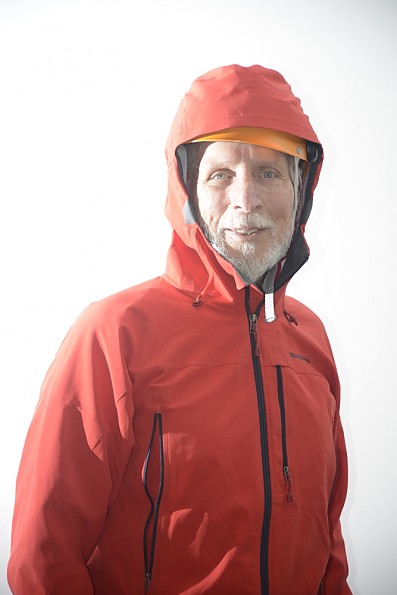
The hood fits over a climbing helmet, but is a bit tight for a ski helmet (at least for the medium I received – the large may allow more room). There is an elastic drawcord to tighten the fit around the helmet or your head when not wearing a helmet. There are also two sets of elastic draw cords to either side of the face opening of the hood to adjust the face opening of the hood. The cord and stops are hidden inside the jacket material, which is nice in that you do not have a large amount of cord hanging in loops to catch on branches. A similar arrangement handles the adjustment at the bottom of the jacket.
The inside back of the neck area has a soft cover which is primarily intended to keep your body oils from getting on the Polartec Powershield Pro fabric. Body oils on the inner side of both DWR and waterproof-breathable fabrics result in causing wetting out. This covering also helps when washing the jacket to remove dirt and body oils.
The cuffs of the sleeves are the common hook and loop fastening. As already mentioned, the jacket does not have pit zips. In the wearing tests (below), it proved to breathe well enough in most conditions that this was not a problem. There were a few times during steep climbs up trails wearing a heavy pack that I had the jacket fully unzipped (recall that the zipper is only top down, no bottom-up available) that I wished for pit zips. This is the same problem with other softshells I have as well. Since the jacket pockets are mesh on the inside of the jacket, they might provide some extra ventilation when unzipped.
The shower test in lieu of our more usual winter rains in California
Details of field testing: I did a preliminary, fairly harsh waterproofness test of both the Knifeblade jacket and pants (discussed in a separate review of the Knifeblade Pants) by putting on the pants and jacket, stepping into the shower, and turning it on to high flow rate (temperature setting at 65°F). I turned around so that the jacket and pants were pelted from all sides, but taking care not to let the water in through the face hole of the hood.
After 10 minutes, I could tell that the jacket, though it had seemed to bead up the water at first, was wetting out and passing water to the inside, both through the fabric directly and through the zippers and seams (as mentioned earlier, there is no seam sealing), both for the jacket and pants. This test is equivalent to a torrential downpour.
In this image you can see where the jacket wet out on the shoulders and at the seat.
Snow, unless it was the very wet snow we often get in the Sierra, would not pass through, certainly not the light powder we see in the Wasatch or that I would see in Antarctica or on the upper parts of Denali. It might be a problem at lower elevations in the Andes, where in the valleys you can get torrential downpours, though when you get above 5000 meters, you would be getting cold dry snow.
The areas that wet out most rapidly were the shoulder area and seat. Since I had worn the Knifeblade during several days of yoyo skiing and had carried a pack during other parts of the testing, this is what I would expect for a water-resistant garment. If you look at the ads that are now appearing on the Patagonia web site and in the Patagonia “Mountain” catalog, you see that the depicted usage is mountaineering, not summer thunderstorms in the Rockies. The pants beaded up and shed the water better than the jacket, possibly due in part to the different angle the droplets would be hitting the fabric on the legs.
I wore the jacket on a number of outings by itself and with the pants, including during my hikes up Mission Peak when testing the Pelican 2750 headlamp, walking to the local pizza and ice cream joints in drizzle and fog, and, more to the point, skiing, snowshoeing and ice climbing in the Wasatch (no snow in California, so I had to go to Utah for snow and ice). During one of the Mission Peak hikes, I had dense fog with lots of condensation. Inside the Knifeblade jacket, my clothing remained dry, thanks both to the condensation beading up on the surface of the jacket fabric and the breathability that allowed my perspiration to pass through.
While skiing at Alta (no snowboarders allowed, thank goodness!), I carried my RFID ski pass in the Napolean pocket of the Knifeblade jacket. Most of the time, this was read by the automatic gates without having to resort to the yoga poses I saw many other skiers resorting to, although one of my other hard shells that has a pocket on the upper sleeve works more consistently.
During the light sprinkle we had in early December (only rain we had in the SFBay Area by late January) the droplets just beaded up with no wetting through.
A foggy day on Windy Hill, with lots of condensation - My clothes under the Knifeblade jacket and pants stayed completely dry during the 4 hours of hiking the 9 miles and 2300 feet of accumulated ascent
Conclusions: The Patagonia Knifeblade jacket performed as shown in the catalog and video on the web, albeit a bit short of the “miraculous ultimate fabric” described in words in the catalog. The claim that Polartec’s Powershield Pro fabric “bridges the gap” between soft and hard shell materials is a bit strong, especially since the “soft shell” designation covers a very wide range of very different jackets and pants. The Knifeblade jacket (and pant) do extend the range of conditions from most of the soft shell jackets and pants that I have toward the hardshells.
The jacket performed very well in light rain and in snow, far better than most of the soft shells I have. It breathes much better than the hard shell Goretex and eVent jackets I have. The combination worked very well in skiing in the Wasatch and in the drippy conditions which have substituted for our more usual rainy weather during the November through February season. The jacket (and pants) will definitely have a place in next summer’s Cordillera Blanca expedition for the American Climber Science Program.
Source: received for testing via the Trailspace Review Corps
(Sample provided by Patagonia for testing and review)
Your Review
You May Like
Specs
| Men's | |
|---|---|
| Price |
Historic Range: $189.50-$379.00 |
| Women's | |
|---|---|
| Price |
Historic Range: $264.99-$379.00 |


